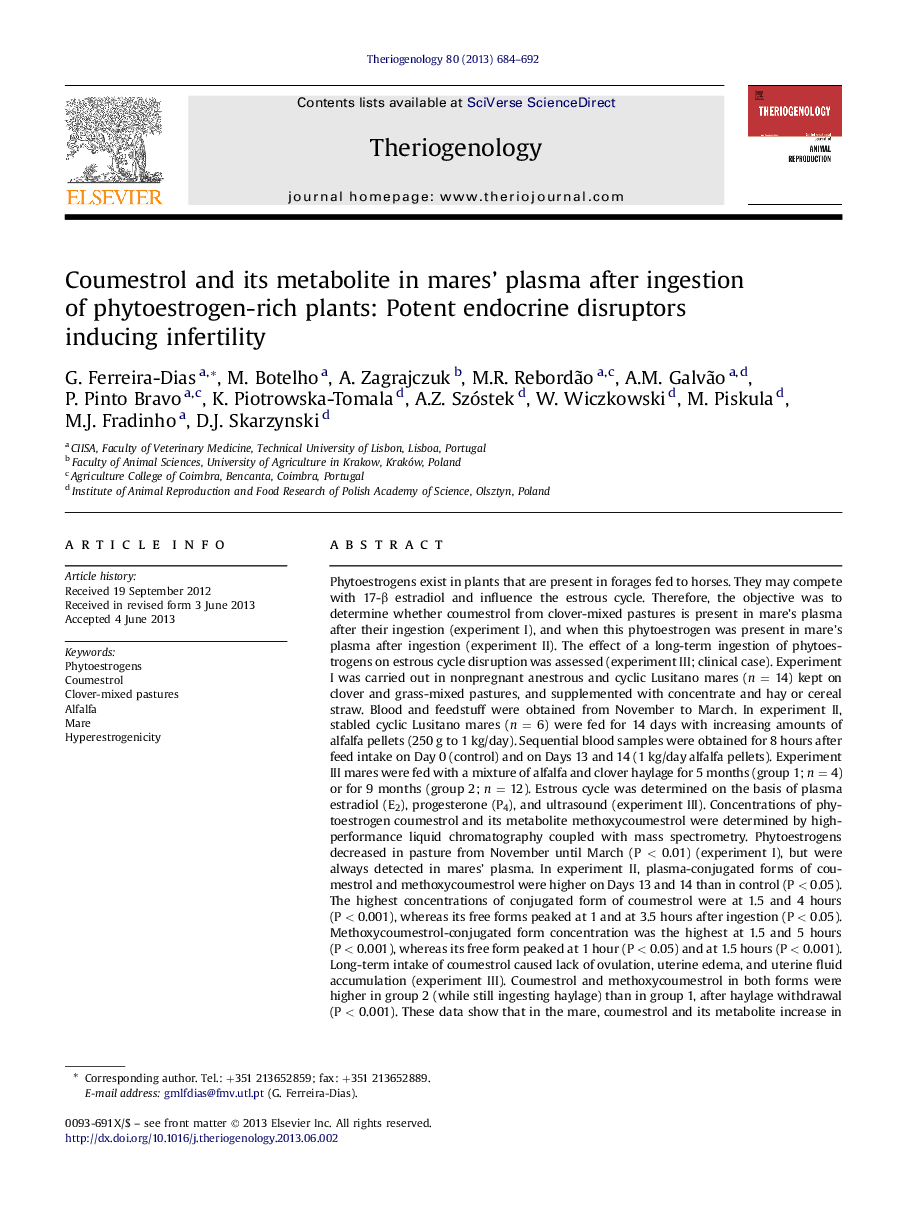| کد مقاله | کد نشریه | سال انتشار | مقاله انگلیسی | نسخه تمام متن |
|---|---|---|---|---|
| 10892313 | 1082098 | 2013 | 9 صفحه PDF | دانلود رایگان |
عنوان انگلیسی مقاله ISI
Coumestrol and its metabolite in mares' plasma after ingestion of phytoestrogen-rich plants: Potent endocrine disruptors inducing infertility
ترجمه فارسی عنوان
کومسترول و متابولیت آن در پلاسمای موش پس از مصرف گیاهان غنی از فیتواستروژن: اختلالهای غدد درون ریز قوی که موجب ناباروری می شوند
دانلود مقاله + سفارش ترجمه
دانلود مقاله ISI انگلیسی
رایگان برای ایرانیان
موضوعات مرتبط
علوم زیستی و بیوفناوری
علوم کشاورزی و بیولوژیک
علوم دامی و جانورشناسی
چکیده انگلیسی
Phytoestrogens exist in plants that are present in forages fed to horses. They may compete with 17-β estradiol and influence the estrous cycle. Therefore, the objective was to determine whether coumestrol from clover-mixed pastures is present in mare's plasma after their ingestion (experiment I), and when this phytoestrogen was present in mare's plasma after ingestion (experiment II). The effect of a long-term ingestion of phytoestrogens on estrous cycle disruption was assessed (experiment III; clinical case). Experiment I was carried out in nonpregnant anestrous and cyclic Lusitano mares (n = 14) kept on clover and grass-mixed pastures, and supplemented with concentrate and hay or cereal straw. Blood and feedstuff were obtained from November to March. In experiment II, stabled cyclic Lusitano mares (n = 6) were fed for 14 days with increasing amounts of alfalfa pellets (250 g to 1 kg/day). Sequential blood samples were obtained for 8 hours after feed intake on Day 0 (control) and on Days 13 and 14 (1 kg/day alfalfa pellets). Experiment III mares were fed with a mixture of alfalfa and clover haylage for 5 months (group 1; n = 4) or for 9 months (group 2; n = 12). Estrous cycle was determined on the basis of plasma estradiol (E2), progesterone (P4), and ultrasound (experiment III). Concentrations of phytoestrogen coumestrol and its metabolite methoxycoumestrol were determined by high-performance liquid chromatography coupled with mass spectrometry. Phytoestrogens decreased in pasture from November until March (P < 0.01) (experiment I), but were always detected in mares' plasma. In experiment II, plasma-conjugated forms of coumestrol and methoxycoumestrol were higher on Days 13 and 14 than in control (P < 0.05). The highest concentrations of conjugated form of coumestrol were at 1.5 and 4 hours (P < 0.001), whereas its free forms peaked at 1 and at 3.5 hours after ingestion (P < 0.05). Methoxycoumestrol-conjugated form concentration was the highest at 1.5 and 5 hours (P < 0.001), whereas its free form peaked at 1 hour (P < 0.05) and at 1.5 hours (P < 0.001). Long-term intake of coumestrol caused lack of ovulation, uterine edema, and uterine fluid accumulation (experiment III). Coumestrol and methoxycoumestrol in both forms were higher in group 2 (while still ingesting haylage) than in group 1, after haylage withdrawal (P < 0.001). These data show that in the mare, coumestrol and its metabolite increase in blood after ingestion of estrogenic plants and can influence reproduction in mares as potent endocrine disruptors.
ناشر
Database: Elsevier - ScienceDirect (ساینس دایرکت)
Journal: Theriogenology - Volume 80, Issue 6, 1 October 2013, Pages 684-692
Journal: Theriogenology - Volume 80, Issue 6, 1 October 2013, Pages 684-692
نویسندگان
G. Ferreira-Dias, M. Botelho, A. Zagrajczuk, M.R. Rebordão, A.M. Galvão, P. Pinto Bravo, K. Piotrowska-Tomala, A.Z. Szóstek, W. Wiczkowski, M. Piskula, M.J. Fradinho, D.J. Skarzynski,
